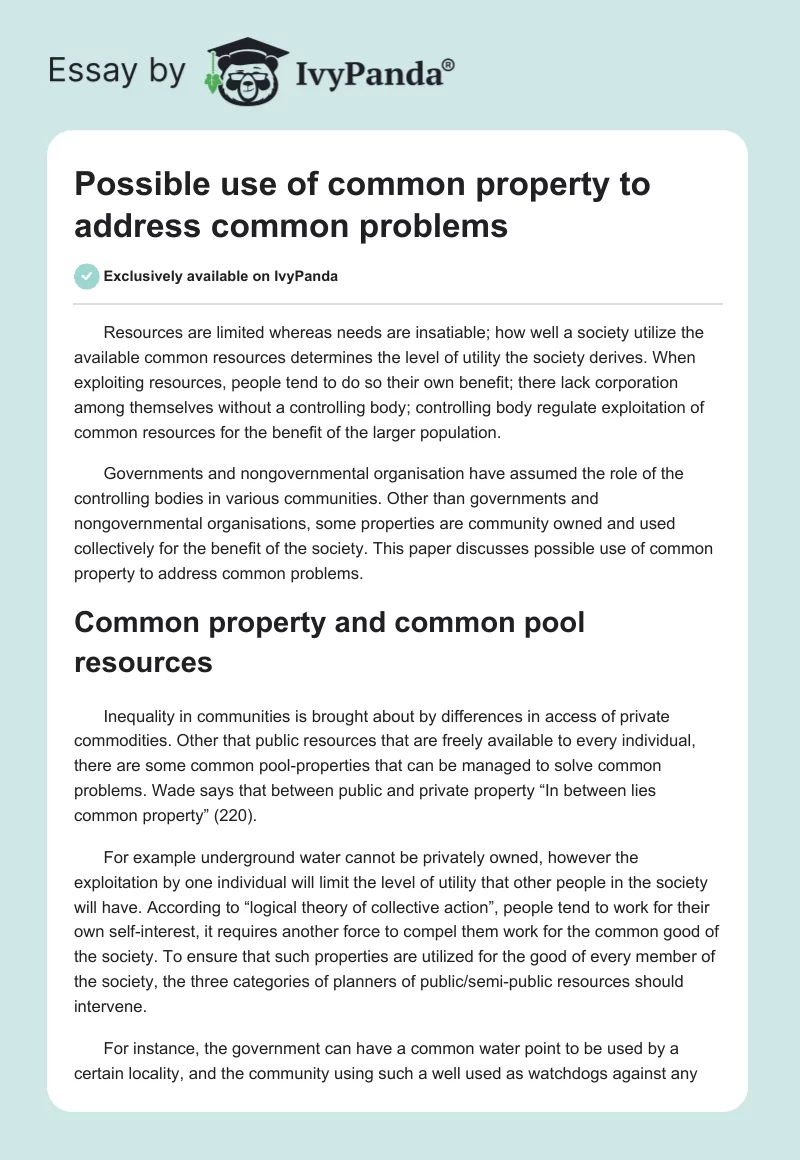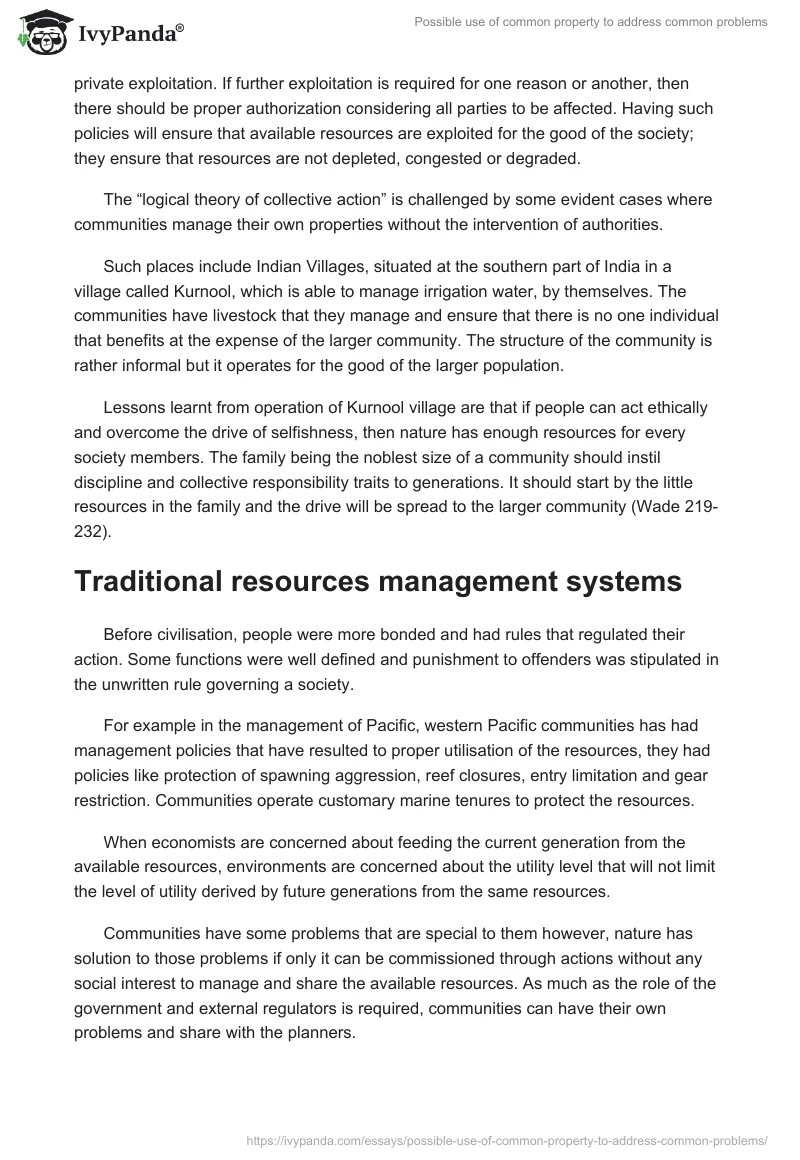Resources are limited whereas needs are insatiable; how well a society utilize the available common resources determines the level of utility the society derives. When exploiting resources, people tend to do so their own benefit; there lack corporation among themselves without a controlling body; controlling body regulate exploitation of common resources for the benefit of the larger population.
Governments and nongovernmental organisation have assumed the role of the controlling bodies in various communities. Other than governments and nongovernmental organisations, some properties are community owned and used collectively for the benefit of the society. This paper discusses possible use of common property to address common problems.
Common Property and Common Pool Resources
Inequality in communities is brought about by differences in access of private commodities. Other that public resources that are freely available to every individual, there are some common pool-properties that can be managed to solve common problems. Wade says that between public and private property “In between lies common property” (220).
For example underground water cannot be privately owned, however the exploitation by one individual will limit the level of utility that other people in the society will have. According to “logical theory of collective action”, people tend to work for their own self-interest, it requires another force to compel them work for the common good of the society. To ensure that such properties are utilized for the good of every member of the society, the three categories of planners of public/semi-public resources should intervene.
For instance, the government can have a common water point to be used by a certain locality, and the community using such a well used as watchdogs against any private exploitation. If further exploitation is required for one reason or another, then there should be proper authorization considering all parties to be affected. Having such policies will ensure that available resources are exploited for the good of the society; they ensure that resources are not depleted, congested or degraded.
The “logical theory of collective action” is challenged by some evident cases where communities manage their own properties without the intervention of authorities.
Such places include Indian Villages, situated at the southern part of India in a village called Kurnool, which is able to manage irrigation water, by themselves. The communities have livestock that they manage and ensure that there is no one individual that benefits at the expense of the larger community. The structure of the community is rather informal but it operates for the good of the larger population.
Lessons learnt from operation of Kurnool village are that if people can act ethically and overcome the drive of selfishness, then nature has enough resources for every society members. The family being the noblest size of a community should instil discipline and collective responsibility traits to generations. It should start by the little resources in the family and the drive will be spread to the larger community (Wade 219-232).
Traditional Resources Management Systems
Before civilisation, people were more bonded and had rules that regulated their action. Some functions were well defined and punishment to offenders was stipulated in the unwritten rule governing a society.
For example in the management of Pacific, western Pacific communities has had management policies that have resulted to proper utilisation of the resources, they had policies like protection of spawning aggression, reef closures, entry limitation and gear restriction. Communities operate customary marine tenures to protect the resources.
When economists are concerned about feeding the current generation from the available resources, environments are concerned about the utility level that will not limit the level of utility derived by future generations from the same resources.
Communities have some problems that are special to them however, nature has solution to those problems if only it can be commissioned through actions without any social interest to manage and share the available resources. As much as the role of the government and external regulators is required, communities can have their own problems and share with the planners.
They should be included in decision making regarding the exploitation of resources in their locality by foreigners and locals. For example in the case of Western Pacific, the communities know when reefs should be closed for various reasons. Their understanding is better than what an outsider can understand. Ignoring the views of the community will lead to degradation and overexploitation of available resources.
When environments advocate for sustainable developments, they are of the opinion that local people as the holders of resources should be governed to exploit the resources in an acceptable manner. Solving problems of current generation should not be a hindrance to future generation need to solve their problems.
Technology and efficiency in resource utilisation will go a long way in ensuring that local resources are well utilized. Some technologies may be as simple as the use recycling while others may be complex like automation of an industry to ensure there is minimal pollution from its processes. Managing of an economy has three main parties, the government (public sector), private sectors and individuals. They should all understand that they have a role in managing common problems for the good of the larger population.
Let us take an example of water resources; some parts of the world hardly have enough water, in such a situation, the government should device policies that manage the exploitation of water resources available. Firms (private sector) should use water effectively and recycle the recyclable; they should look into their waste disposal mechanisms not to pollute water sources. At household level, people should use water effectively and ensure. When such a situation is reached, then common problems can be solved through common properties.
Social economic factors have resulted to common problems; as people trade and industrialize; they need to have good common infrastructures. Marine tenures has been affected by social economic factors like population growth, industrialisation and have hampered the community management of Papua New Guinea and Indonesian marine resources.
According to article by Joshua Cinner, communities have developed to have different expectation and needs common property management can only solve. However, Cinner observes that community based approach to social problems “may be somewhat resilient to other social economic needs like population” (36).
For example in modern society, people are in need of transport and communication systems. It facilitates trade among communities. In such a situation, common properties available is in the form of taxes paid to local government which if well managed, then local government can provide these property to the communities and solve their problems. The pooling of resources together has assisted to have a solution to the available needs.
As much as community policies as brought forth by Joshua Cinner can be effective, they become obsolete with time and new innovations. There is need to review the management of resources if current problems of a generation will be solved (Cinner 36).
The Tragedy of the Commons
Hardin observes, “A finite world can only support a finite population” (1243). Hardin Garrett is of the opinion that people keep changing their traditional professions in the search for better ways to fulfil their needs and solve their problems. Population increase amidst limited resources calls for better ways to utilize the available resources. Human beings have energy that they can utilize to solve their problems. The potential they are given at one particular point can be used to solve problems of that particular generation.
Tragedy of freedom of the common theory is of the opinion that rational human being tend to maximize their gains and manage against any shortcomings that can make them suffer. In the efforts of maximizing their utility and benefits, people find themselves adding more problems to the environment. This is through pollution as they produce goods and services. The theory is of the opinion that people create their own problems and to solve them they need to be governed in one way or another.
To avoid pollution, the government should intervene and regulate public properties that are subject to pollution like atmosphere, temperature and soils. Then they should devise policies to ensure compliance with the set rules and regulations such policies include taxation on pollution and automation of production processes.
They should also target person’s conscience and develop policies that can attain common good. This can be done through consolation with local communities. People should recognise the needs of a current generation and future generation and aim not to limit solutions generation of either generation (Hardin 1243-1248)
Conclusion
Current generation should use available common resources to solve their common problems without limiting the capability of future generation in solving their problems. This calls for effective resources management and intervention of all stakeholders, which are government, international community, private sector, communities, and individuals.
Works Cited
Cinner, Joshua. “Socioeconomic Factors Influencing Customary Marine Tenure in the Indo-Pacific”. Ecology and Society 10.1 (2005): 36. Print.
Hardin, Garrett. “The Tragedy of Commons”. American Association for the advancement of Science. 162. 3859 (1968): 1243-1248. Print.
Wade, Robert. “The Management of Common Property Resources: finding a corporate Solution”. Research Observer 2. 2. (1987): 219-232. Print.


